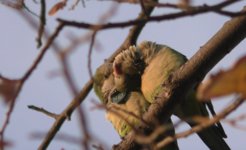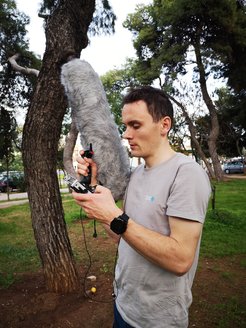More social parrots have a better vocabulary
How social networks shape the vocal diversity of monk parakeets

To the point:
- Complex communication: Researchers studying the social networks of monk parakeets in Spain uncovered a link between an animal’s social ties and the calls that it makes.
- Levels of sociality: They spent two years recording the social lives, as well as all screeches, squawks and whistles, of over 300 parrots—linking what individuals say to very specific levels of sociality.
- Roots of language: These results shed light on how sociality might have driven the evolution of complex communication and ultimately of human language.
In the urban parks of Barcelona, Spain, the calls of a tropical parrot fill the air. The bright green monk parakeet, native to South America, has found a new home in European cities. Monk parakeets thrive in huge colonies where they communicate with each other using many distinct sounds—offering scientists a unique window into understanding the interplay of individual social relationships with vocal variety.
For social animals, communication is a key that unlocks the benefits of group living. It’s well known that animals with more complex social lives tend to have more intricate ways of communicating, from the clicks and whistles of dolphins to the calls of primates. While this pattern is found broadly in many species, a new study on wild parrots drills deep into the social and vocal lives of individual birds. Researchers at the Max Planck Institute of Animal Behavior (MPI-AB) analyzing the social networks of monk parakeets in Spain have uncovered how an individual’s social ties shapes the calls these birds make.

The MPI-AB scientists spent several months over the course of two years closely observing 337 monk parakeets, documenting their social lives as well as recording all their screeches, squawks, and whistles, which totaled 5,599 vocalizations. The team examined these calls in terms of repertoire diversity (how many different sounds a bird can make) and contact-call diversity (how much this specific type of call differs). They also mapped out the birds' social networks, analyzing everything from how often they interacted with others to the strength of their relationships.
Based on this data, the team could conclude that individual parakeets living in larger groups did indeed produce a more variable repertoire of sounds. They also found that female parakeets had a more diverse repertoire than males, which is unusual for birds, they say.
“This research is a really important first step,” says Simeon Smeele, the first author of the study. “It really looks like there are some call types that are used uniquely in social situations. And it’s really interesting to see that females appear to produce more of these, suggesting they are the more social sex.”
Social network analysis showed that parakeets with more central positions in the social structure—those that were potentially more influential in the group—tended to have more diverse vocal repertoires. In other words, the most social individuals seemed to have a better vocabulary than less social individuals.
“What I find really exciting is that we were able to link what individuals say to very specific levels of sociality,” says Smeele, who conducted the study as a doctoral student at MPI-AB. “For example, close friends that allowed each other to approach within pecking distance sounded less like each other, as if they were trying to sound unique in their little gang.”
The results offer clues about the evolution of complex communication including human language. Previous research has demonstrated that sociality is linked to a more diverse repertoire in species ranging from Carolina chickadees to marmosets. This study goes further by showing how vocal communication is shaped by the web of an individual’s social network.
Says Smeele: “The next big step is to better understand what each of the sounds mean, a real mammoth task, since most of the social squawking happens in large groups with many individuals talking at the same time!”













